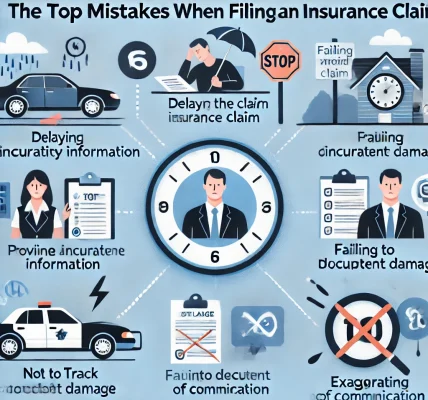Insurance claims play a crucial role in securing financial protection against unforeseen circumstances. Whether it’s a health emergency, property damage, or a vehicular accident, an insurance claim helps policyholders recover their losses. However, navigating the complex landscape of insurance claims can be challenging. This guide provides an in-depth look at various types of insurance claims, the process of filing them, and key considerations to ensure a smooth settlement.
What is an Insurance Claim?
An insurance claim is a formal request made by a policyholder to an insurance company for compensation or coverage of a covered loss. Once a claim is filed, the insurer reviews it, assesses the validity, and provides financial support as per the terms of the policy. Understanding the different types of insurance claims helps policyholders prepare for emergencies and ensure compliance with legal requirements.
Types of Insurance Claims
1. Health Insurance Claims
Health insurance claims arise when a policyholder seeks coverage for medical expenses. These claims can be filed in two ways:
- Cashless Claims: The insurer directly settles the medical bills with the hospital.
- Reimbursement Claims: The policyholder pays for medical expenses upfront and later claims reimbursement from the insurer.
Key Considerations:
- Ensure treatment is taken at network hospitals for cashless claims.
- Maintain all medical documents and receipts for reimbursement claims.
- Follow the claim submission deadlines specified in the policy.
2. Auto Insurance Claims
Auto insurance covers damages or losses related to vehicles. Common types of auto insurance claims include:
- Accidental Damage Claims: Covers repair costs for vehicle damage due to accidents.
- Theft Claims: Provides compensation if the vehicle is stolen.
- Third-Party Liability Claims: Covers damages caused to third-party property or individuals.
- Comprehensive Claims: Covers damages due to natural calamities, vandalism, or riots.
Key Considerations:
- File a First Information Report (FIR) for theft or significant damages.
- Document the accident scene with photographs and witness details.
- Inform the insurer immediately to avoid claim rejection.
3. Home Insurance Claims
Home insurance claims provide financial support for property damage due to unforeseen events such as fires, natural disasters, burglaries, or structural failures. Types of home insurance claims include:
- Structural Damage Claims: Covers repair costs for structural damages due to disasters.
- Burglary & Theft Claims: Covers stolen items and repair costs for damaged locks or doors.
- Liability Claims: Covers legal expenses if someone gets injured on the property.
Key Considerations:
- Document damage with photographs and videos.
- Keep receipts of valuables for accurate claim assessment.
- Report incidents to authorities before filing a claim.
4. Life Insurance Claims
Life insurance claims are filed by beneficiaries in case of the policyholder’s demise. These claims fall into two categories:
- Death Claims: Filed by the nominee or beneficiary after the policyholder’s death.
- Maturity Claims: Filed when a policy matures, and the insured survives the policy term.
Key Considerations:
- Submit a death certificate, policy documents, and identity proof of the nominee.
- Understand policy exclusions, such as suicide clauses within the initial policy years.
- Ensure the premium payments are up-to-date to avoid claim denials.
5. Travel Insurance Claims
Travel insurance covers financial losses related to trip cancellations, lost baggage, medical emergencies, or accidents while traveling. Common travel insurance claims include:
- Trip Cancellation/Interruption Claims: Provides reimbursement for trip cancellations due to emergencies.
- Lost or Delayed Baggage Claims: Covers compensation for lost or delayed baggage.
- Medical Expense Claims: Covers hospitalization and medical treatment costs while traveling.
Key Considerations:
- Keep all travel-related receipts and medical reports.
- Report lost baggage or theft to airport authorities and police.
- Check for exclusions such as pre-existing medical conditions.
6. Business Insurance Claims
Business insurance protects companies from financial losses due to property damage, employee-related risks, and liability claims. Common claims include:
- Property Damage Claims: Covers damages to business premises due to fire, floods, or other disasters.
- Business Interruption Claims: Covers loss of income due to unforeseen disruptions.
- Liability Claims: Covers lawsuits related to third-party injuries or damages caused by the business.
Key Considerations:
- Maintain accurate business records for claim validation.
- Report incidents promptly to the insurer.
- Understand policy coverage limits and exclusions.
Steps to File an Insurance Claim Successfully
- Notify the Insurer: Inform the insurance company about the loss as soon as possible.
- Gather Documentation: Collect necessary documents such as receipts, medical reports, FIR (if required), and photographs.
- Complete the Claim Form: Fill out the claim form with accurate details and attach supporting documents.
- Submit the Claim: Send the completed form and documents to the insurer via the prescribed method.
- Claim Assessment: The insurer reviews the claim and may request additional information.
- Settlement or Rejection: The insurer either approves and settles the claim or rejects it based on policy terms.
Common Reasons for Claim Rejection
- Incorrect or Incomplete Information: Providing inaccurate details can lead to rejection.
- Failure to Disclose Information: Non-disclosure of pre-existing conditions or policy exclusions.
- Missed Deadlines: Delay in filing claims beyond the specified timeframe.
- Lack of Proper Documentation: Missing or inadequate proof of loss.
Conclusion
Understanding different types of insurance claims helps policyholders navigate the claims process efficiently and ensures smooth settlements. By following proper documentation, timely reporting, and compliance with policy terms, individuals and businesses can maximize their chances of claim approval. Always read the policy document carefully and consult with the insurer if any doubts arise.




